I find this video somewhat disturbing, no less than because there’s an awful lot of empirical evidence in there.
A whole bunch of sacred cows may become BBQ, I think.
All comments are welcome.

I find this video somewhat disturbing, no less than because there’s an awful lot of empirical evidence in there.
A whole bunch of sacred cows may become BBQ, I think.
All comments are welcome.
Last word on the .444 Marlin comes from Reader Mike S:
“I shot a TC Contender w/14-in. bbl. chambered in 444 Marlin. Once.
I couldn’t feel my right hand for 5 minutes. Then wished I couldn’t.
“Muzzle Flash” is such an inadequate phrase.”
The .444 is not a pistol cartridge, no matter what you might be told.
Longtime Readers will all know of my fondness for the venerable 6.5x55mm Swede (SE), and I happened on an article which gives chapter and verse to this wonderful cartridge.
With all due respect to its larger 7mm / .30 siblings, I stand firm in my belief that the Swede is quite possibly the perfect medium-game cartridge, the excellence of the .308 Win, .30-06 Springfield and so on notwithstanding. When you take all the factors of shooting into account: bullet velocity, flatness of trajectory, penetration, and most especially recoil, the sum of the Swede’s parts of this equation are probably higher than the bigger cartridges. Here’s a pic I’ve posted before, comparing the Swede to its contemporaries:
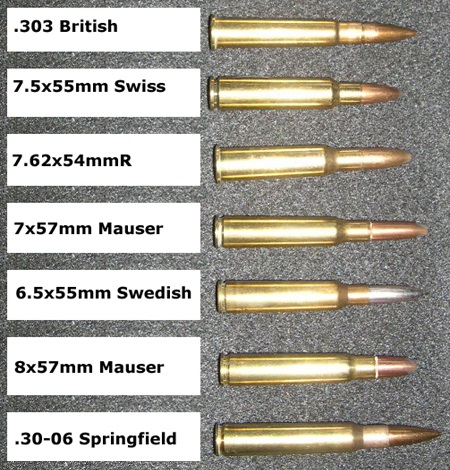
Here it us with some other “quarter-inchers”:
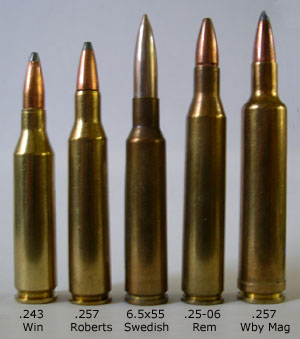
And finally, vs. the .308 Win (my “1.a” choice for a do-it-all cartridge):
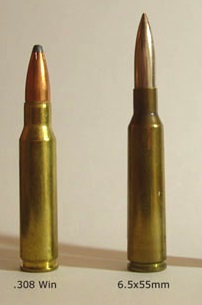
I will say unreservedly that if I were limited to only one cartridge for “ordinary” (i.e. excluding African large game) hunting whether human or animal, the Swede would get my vote ahead of every other cartridge I’ve ever fired.
The only caveat I have is that the Swede doesn’t seem to do as well in shorter-barreled rifles. I think that in standard loadings — and certainly with the Hirtenberg mil-surp stuff — the bullet needs a longer barrel to get that bullet spinning towards its performance apex. And the ultimate expression of that is in the wonderful Mauser Mod 96 with its 29″ barrel, as never used (in combat) by the Swedish Army:

In my earlier post on Great War Rifles, I said:
But of all the rifles issued to soldiers of that era, the one I’d have chosen to go to war with would have been the Swedish Model 1896 Mauser. It has moderate recoil, yet the bullet travels flat and hits hard. The rifle is also fantastically accurate: consistently-placed head shots at 400 meters and torso shots at 600 meters are quite possible even for an average shot like myself.
I haven’t changed my mind since.
That said, I have old eyes and the iron sights would be problematic — but mounting a scope on the old M96 can be tricky, with that 90-degree-lift straight bolt. So I’d have to take instead my current love, the CZ 550 with its 24″ barrel:

Compromises… we all have to make them.
Having established that Ye Olde Eyes were no longer up to the task of using a rifle’s iron sights to actually hit anything, I decided to quit fooling myself and accept that Time Marches On, and leaves one’s eyesight in the rearview mirror.
I had an old Firefield 1×22 red-dot scope lying around, so I mounted it onto the Savage 94F wot my kids gave me for the latest birthday, thus:

…and headed off to the range. I decided to try the Aguila ammo this time:
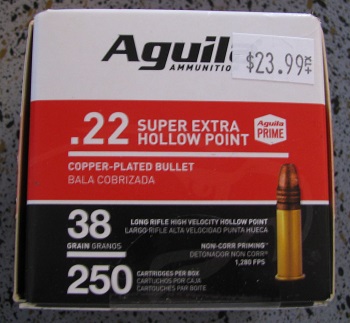
(Note the price… ugh.)
I first messed around at the pistol range, simply to get the bullets “on paper”, then moved to the rifle range, which can accommodate things like rests and such to get the job done properly.
Now the Firefield, as its description indicates, has 1x (i.e. no) magnification (which really doesn’t help Men Of Failing Eyesight such as myself), so I wasn’t sure just how precisely I would be able to zero the thing. Nevertheless, I persevered. In order of shooting, 25 yards at 3″ targets:

Played around a bit (two 5-round strings):
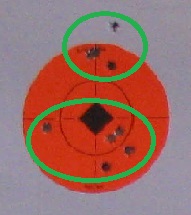
Then I got a little more serious, shooting the smaller 2″ targets at 15 yards (because at 25 yards, the red dot was almost larger than the 2″ target):
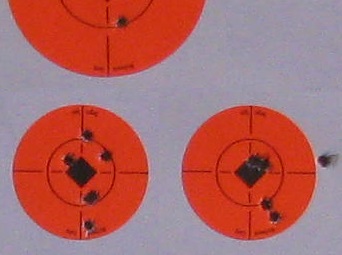
But try as I may, I couldn’t get groups to tighten up any more than that — always four decent rounds and a flyer. So I started to get irritated, and got really serious — except that I was getting worse, not better:

I gave up, and did two “torture tests” — rapid fire, one shot per 1″ target, then repeated the exercise in the same order:
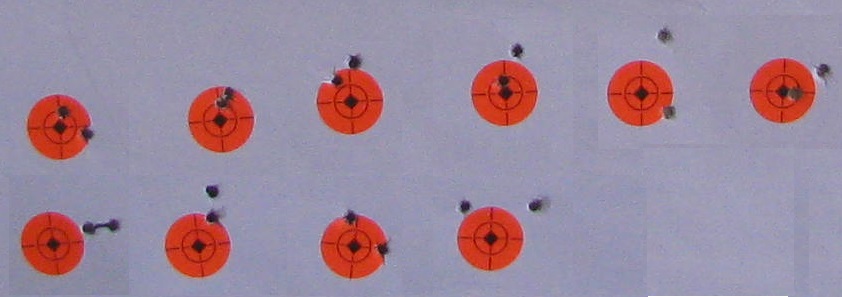
I’ve done better with a damn pistol, shooting offhand. I was getting seriously angry at myself.
I was done for the day but I had five rounds left over, and I hate having loose rounds rattling around in the gun bag — you know what’s coming, right?
I loaded them up, put one round into some white space on the target, then shot off the last four as quickly as I could pull the trigger, using only the first bullet-hole as the aiming point:
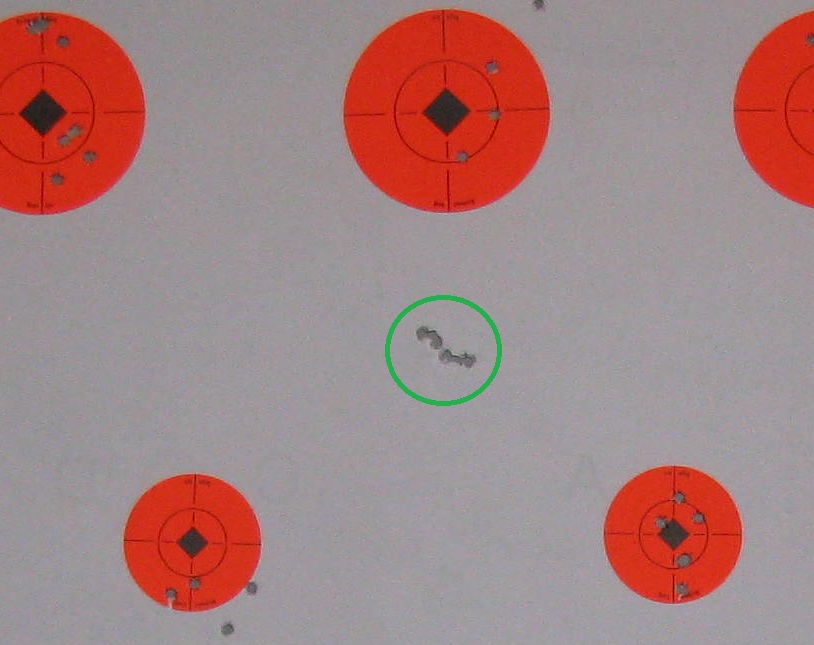
Okay, I have to admit that I felt a lot better after that.
Afterthought: I forgot to mention that this Aguila variant is consistently accurate in pretty much all my rimfire guns. All flyers are therefore very definitely the result of “operator error”…
I really wish I had the tech and such to be able to do stuff like this. Alas, my time has come and gone, but I still enjoy the hell out of ol’ Gramps Hitchcock45, who is my kinda guy altogether.
Take a half-hour out of your day to watch the comparison. The only way it could be more fun for me is if I’d been there with him.
In Comments about the .375 H&H cartridge, Fergie asks:
I wonder why the venerable .45-70 isn’t on the table for him? North American bison are heavyweights too, and .45-70 will handle them with aplomb even at range. I wouldn’t hesitate if offered a decent shot at that critter – a properly stoked cartridge with a hard cast 500 grain round nose from an elegant 1885 single shot would end the hunt nicely.
I’ve thought about that a lot myself (not owning a rifle chambered in .375 H&H, but owning the aforesaid 1885 High Wall rifle in .45-70 Govt).
I remember looking at the situation back when I was thinking of joining Mr. Free Market and Doc Russia on a South African safari, and basically I was told that the PH wouldn’t let you hunt Cape buffalo with the .45-70 Govt because it’s too underpowered. I bridled a little at that, and went looking around.
Here’s what the stats say about Buffalo Bore .45-70 Govt “Magnum” offerings:
Mono-Metal Flatnose: 380 gr. @ 2,075 fps / muzzle energy 3,632 ft-lbs
LBT-LFN: 430 gr. @ 1,925 fps / muzzle energy 3,537 ft-lbs
FMJ-Flatnose: 500 gr. @ 1,625 fps / muzzle energy 2,931 ft-lbs
Compare that to Buffalo Bore’s own .375 H&H Mag offering, which they call “Supercharged”:
SUPERCHARGED: 300 gr. Barnes TSX @ 2,550 fps / muzzle energy 4,330 ft lbs
Here’s the critical part, though. Most PHs recommend that the bullet arrives with no less than 3,000 ft-lbs at 100 yards.
At 100 yards, the .375 H&H Hornady DGS 300gr lands at 3,292 . The Buffalo Bore .45-70 Govt (or any manufacturer’s, for that matter)? Anywhere from 2,500 – 2,700 ft-lbs. Not nearly enough; those big, heavy ol’ boolets lose velocity too quickly.
More telling is the bullet’s ballistic coefficient (BC) / sectional density (SD) or, for a better definition, penetration power. (The higher the BC / SD, the better the penetration.)
At about 2,500 fps (which is at about 175 yards), the .375 H&H 300gr bullet has a BC of 480, and its SD is 305 (480/305).
At 1,900 fps (which is at the muzzle), the .45-70 Govt 300gr bullet has a BC of 185 and an SD of 204 (185/204).
In other words: if you were to shoot a Cape buffalo with the hottest-possible .45-70 Govt cartridge, you’d pretty much have to be in halitosis range to get the same result as you’d get with a .375 H&H cartridge at 100-150 yards.
And as Longtime Friend Combat Controller succinctly put it when we were discussing the topic last night: “If the .45-70 worked in Africa, they’d be using it. They don’t.”
Yup. In any safari camp, when you un-case your .375 H&H rifle, the PH will nod in approval. And especially so when it’s a CZ 550 Safari, a.k.a. the Brno 602.
